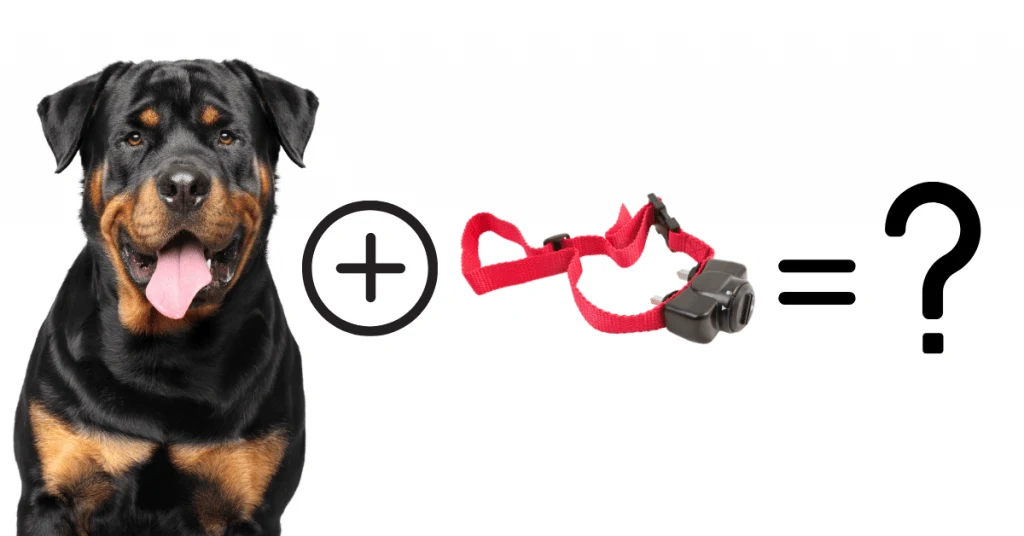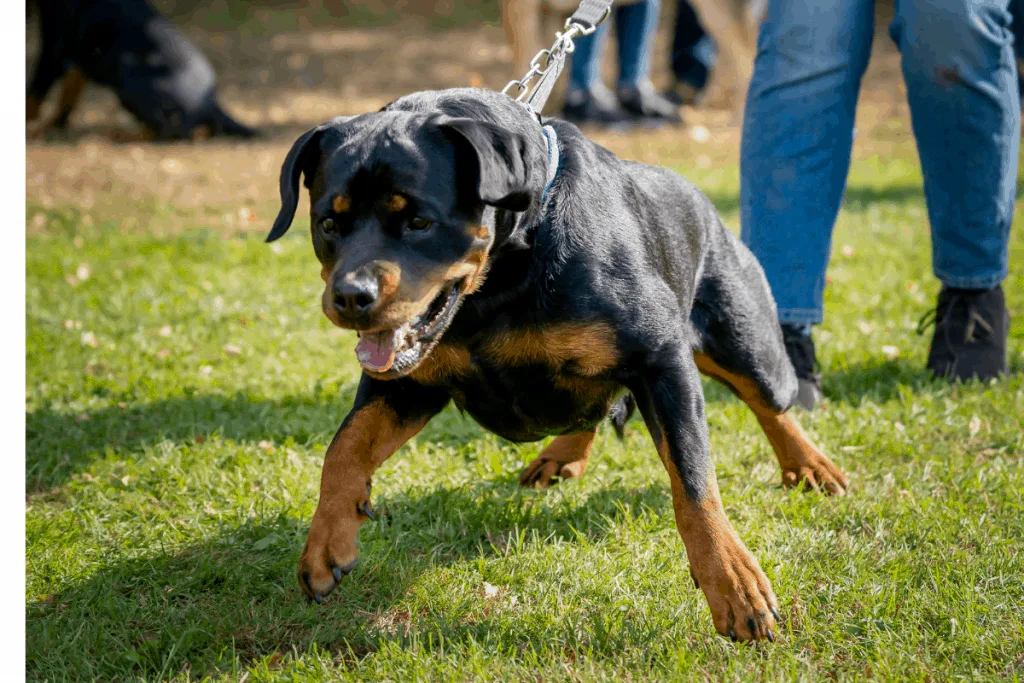
Shock collars are used for aversive training, and they are pretty controversial tools because they do involve inflicting discomfort or pain on the dog.
Some still hold to the opinion that there is merit in the use of these devices, but there is definitely a list of do’s and dont’s when it comes to shock collars.
Shock collars can work on Rottweilers, but correct use is vital. Check if the dog is healthy; don’t use if they aren’t. Does the Rottweiler need it, or can other methods work? Seek expert guidance; don’t wing it. Use for severe problems, not normal training. Ensure the collar works properly and maintain it. Don’t start on high or use around water.
Cesar Millan, The Dog Whisperer, is one notable advocate for the use of the shock collar, or e collar.
But he indicates that the shock collars should only ever be used in severe situations and with the guidance of an expert.
This article looks a little closer at these and other guidelines, and it also lists the best shock collars for Rottweilers.
Click Here to Jump to a Section
How Do Shock Collars Work?
Shock collars deliver an electric impulse to a dog when the collar is triggered. There are three types of triggers:
- The first trigger is a manual one operated by the dog’s owner or handler. The owner or handler will press the button when they see an unwanted behavior that they wish to correct.
- The second trigger is the vibration of a dog’s vocal cords, the sound of their barking, or a unique combination of these that prevents the collar from being triggered by noises other than the dog’s barking. This type of trigger is used to address inappropriate barking habits.
- The third trigger is a sensor that is tripped when a dog comes close to it, acting as a form of containment. This trigger is used when dogs keep escaping from their owner’s property or if they keep entering a space that they are not allowed to.
Shock collars don’t necessarily deliver an impulse that feels like an electric shock. It may be more of a vibration or mild discomfort, but some can cause physical pain, even if it is only momentarily.
Typically, the intensity is adjustable on the shock collar.
The theory behind the shock collar technique is to apply an unpleasant stimulus in response to an unwanted behavior so that they associate the negative result with the negative behavior.
Alternatively, the purpose of the ‘shock’ can be to catch the dog’s attention if they are fixated on something, redirecting their focus and allowing them to calm down.
Another feature of the majority of shock collars is that they emit a beeping sound before the impulse.
This sound can be used with verbal cues so that the collar no longer needs to be employed.
The beep sound or the verbal command will now be associated with the need to correct a behavior.
Do Shock Collars Work On Rottweilers?

Shock collars do work on Rottweilers, but only if they are used correctly. A Rottweiler is able to feel the electrical impulse (even through their thick fur).
Still, unless they know what behavior the electrical stimulation needs to be associated with, all the shock collar is doing is punishing them for no apparent reason.
As this is not the intention of a shock collar, it is imperative that the correct training techniques are used.
1. Do Get Your Rottweiler’s Health Checked Before Using A Shock Collar
Shock collars involve electrical impulses, so you have to make sure that your Rottweiler doesn’t have any health conditions which may be triggered or aggravated by this electrical stimulation.
This will require a veterinarian check-up. Take your Rottweiler to the clinic and inform your vet that you are thinking of using a shock collar.
Explain to them why you have decided to investigate this avenue and tell them that you first want to make sure that your Rottweiler is fully healthy.
Your veterinarian may advise you not to proceed with using a shock collar, whether your Rottweiler is unhealthy or not.
Listen to their reasoning, ask them what alternatives they would recommend, and make your decision from there.
2. Don’t Use A Shock Collar On Your Rottweiler If They Are Unhealthy
There are two issues here. The first is that your Rottweiler’s negative behavior may actually be a symptom of a health condition.
Chronic pain can lead to aggression. Brain tumors can be the cause of seemingly obsessive behaviors, like barking, food snatching, etc., and also aggression.
If your Rottweiler is acting out because of a health condition, they need to be medically treated, not aversively trained.
The second issue is that heart and brain conditions may be triggered by even the slightest electrical stimulation. This is because the cardiovascular system and the nervous system are controlled by electrical impulses.
Shock collars could trigger cardiac arrhythmias or even cardiac arrest in susceptible dogs, and they can trigger seizures, paralysis, etc., in dogs with nervous system disorders.
3. Do Have Your Rottweiler’s Behavior Assessed By A Professional
Before you start using a shock collar, you should take your Rottweiler for a behavioral assessment.
As a layperson, you may think that you have reached the point where you are out of options. You’ve researched every technique, and nothing works.
You need to remember that the internet is a tool and should not be used in place of actual advice.
You may not be using the other techniques correctly, or you may be using the wrong methods altogether.
An in-person consultation with a professional behaviorist or trainer for your Rottweiler (all dogs are different) could reveal something you did not see before, or they may be able to give you advice based on actual experience instead of just theory.
4. Don’t Use A Shock Collar On You Rottweiler If It Is Not The Right Technique
If you can use positive reinforcement with your Rottweiler instead of a shock collar, why wouldn’t you prefer this option? Or even a different aversive technique that is safer?
Make absolutely sure that the shock collar is the only option before you proceed with using it.
Furthermore, your Rottweiler may not respond to the shock collar.
They will feel the electrical impulse, but it may just worsen the behavior or be perceived as a separate issue to the behavior, no matter how you use it.
A behaviorist or trainer should be able to help you figure out if this method will even be effective for your dog.
5. Do Seek Advice From A Professional On What Shock Collar To Buy And How To Use It With Your Rottweiler
Using a shock collar should never be done lightly or without properly considering the purpose and execution of this pretty extreme method.
Never just purchase the cheapest option. Seek advice from an expert on which collar is best, and more specifically, which is best for your Rottweiler.
Then you need to ask them to teach you how to use it. This does not just refer to the actual mechanics of the device. You need to know things like:
- How to introduce the shock collar
- When to put it on and take it off
- When and by how much you should increase the intensity of the shock
- When to trigger the impulse
- When you should not be triggering the impulse
Shock collars are supposed to be a training technique, not just a punishment.
Your Rottweiler has to learn that when they do this, that’s when the impulse is administered, so they should stop doing that.
A Caution For Containment Shock Collars
If you are using a containment shock collar, then make sure the Rottweiler knows it’s when they jump the fence or enter the chicken coop, etc., that they receive the correction.
You don’t want them to be wondering why they were shocked and think that they are not allowed outside or near any fence.
Furthermore, if your Rottweiler does escape, they will also be shocked when trying to return, which can cause a lot of confusion.
A Caution For Barking Shock Collars
Another issue you will have to discuss with a professional is using the shock collar to stop barking.
Barking can be a very serious issue. Neighbor complaints can lead to legal action. You hear stories of people who have had to move or rehome their dog because of barking.
However, Rottweilers are naturally protective dogs. This is one of their best qualities and one of the reasons why they make such excellent companions and family pets.
You don’t want your Rottweiler to start thinking that all barking is bad because then they may hesitate to warn you of a threat to your home, family, and personal safety.
It can also cause your Rottweiler distress as they wish to protect you and feel that they cannot.
6. Don’t Use A Shock Collar For Normal Training With Your Rottweiler

Never use a shock collar for normal obedience training or as a first training method. These devices are not an alternative to positive or less extreme aversive training techniques. Shock collars should rather be viewed as a last resort.
Positive training methods are always the first-choice options, and they yield excellent results under most circumstances.
Some people do use shock collars for training dogs for things like hunting or sporting, but why would you if positive techniques would work just as well?
7. Do Use A Shock Collar To Deal With You Rottweiler’s Problem Behaviors
If your Rottweiler is in desperate need of behavioral correction, but other methods are not working, then the shock collar becomes an option.
It also moves from being a last resort to being the best option if the alternatives are to rehome or even euthanize your Rottweiler.
8. Do Test The Shock Collar Before Using It On Your Rottweiler
Before you use a new shock collar, you should test it to make sure that it is working correctly.
A manufacturing fault or an issue caused by damage could lead to a number of malfunctions.
The trigger may get jammed, preventing the shock from ceasing, or the mechanism may trigger randomly.
There may also be a problem with the gradation of the intensity or the maximum intensity leading to excessive electrical shock.
Many people opt to test the collar out on themselves before putting it on their dog.
One person even reports that they try the device to make sure it’s working correctly every day before putting it on their dogs.
9. Don’t Start Your Rottweiler At The Highest Intensity Of The Shock Collar
The shock is a new sensation for your Rottweiler; even the lowest intensity may be enough to catch their attention.
If the lowest setting does not work to snap your Rottweiler out of their hyper-focused state or cause them to reassess, then you can try to increase the setting to the next point.
10. Do Keep The Shock Collar Maintained
Just like other electrical equipment, it is imperative to maintain it in good working order. Things can go wrong, parts can break, circuits can be damaged, etc.
Always make sure that the collar is in tip-top working order. After all, your Rottweiler is your best friend, so you want to make sure everything is as safe as can be.
11. Don’t Use If Your Rottweiler Is Or Could Get Wet
Water is an electrical conductor, so you have to be very aware of moisture when using a shock collar. If your dog is wet, do not put the shock collar on them.
If your Rottweiler is a swimmer and is constantly wet, this might not be the right option, or you may have to seal off their access to the pool while you deal with the problem behavior.
You also have to be careful about containment collars and barking collars if you leave them on your Rottweiler when you go out.
If you Rottweiler is outside, then it can rain, they can splash in their water bowl, or go swimming (you should prevent access to swim spots if you leave them with a shock collar on).
Then, when they approach the boundary or bark, the resultant electrical impulse will be magnified by the water on their coat and skin.
Another situation to consider is if your Rottweiler gets very sweaty on hot days or with exercise. Sweat is a very good conductor of electricity, and dogs often get sweaty around their collars.
The 7 Best Shock Collars For Rottweilers

Before we get to the list of the best collars for Rottweilers, you have to remember that your Rottweiler is different from every other Rottweiler. This is why it is important to seek expert help when choosing a shock collar.
However, you should not go to an expert unprepared. Do your own research because they might know dogs, but you are the best person to know your dog.
Before we begin with our list , we think that it will be beneficial for you to see just how strong of a shock these collars actually inflict on a dog, or rather, a human!
Here, dog behavior specialist Blake Rodriguez maxes out the first (and tied for best) remote collar on our list. See the results for yourself!
Best Overall (Tie)
Educator E-Collar Remote Dog Training Collar
Best Overall (Tie)
PetSafe Remote Training Collar—300 yards
Best for Big Dogs
PetSafe Big Dog Remote Training Collar
Best Affordable Collar
PATPET P301 300M Remote Dog Training Collar
Best Remote Collar
Best Sporting Collar
SportDOG Brand 425X Remote Trainers
Best No-Bark Collar
Final Thoughts
A lot of people have an opinion on shock collars and the safety or humanity of their use.
Still, there are situations where shock collars can be appropriately used to prevent a bad situation from becoming worse.
As shock collars have the potential to harm your Rottweiler, it is imperative for you to heed the guidelines presented in this article to make the experience as safe as possible for your dog.
